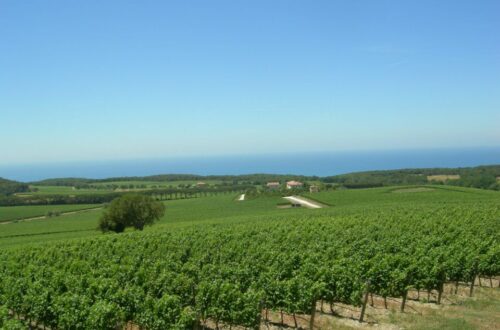Table of Contents
What Is Bosco Eliceo DOC?
Bosco Eliceo DOC is one of Emilia-Romagna’s most coastal and characterful wine zones, stretching along the Adriatic near Ferrara and Ravenna. Nicknamed “the wines of the sands”, they grow on ancient seaside dunes shaped by salt breezes and brackish lagoons. Here, frizzante Fortana reds and crisp Trebbiano-based whites capture the maritime essence of northern Italy.
History of Bosco Eliceo Wines
The wines of Bosco Eliceo trace their story back to the Renaissance courts of Ferrara. Local legend credits Duchess Renée of France, wife of Duke Ercole II d’Este, with introducing the Fortana grape (also called Uva d’Oro) to the region in the 16th century.
Unlike many Italian vineyards, Bosco Eliceo vines survived the phylloxera crisis of the 19th century, thanks to their sandy soils which naturally resist the pest. This makes the vineyards a living link to Italy’s pre-phylloxera viticultural past.
Terroir: Emilia-Romagna’s Coastal Wine Zone
The Bosco Eliceo DOC zone lies on the low-lying Adriatic coast, where vineyards intermingle with pine forests, wetlands, and sand dunes.
- Soils: Predominantly sandy, mineral-rich, and phylloxera-resistant.
- Climate: Maritime influence moderates extremes, with salty breezes contributing freshness and salinity to the wines.
- Landscape: Vineyards are often just steps from the Adriatic, making Bosco Eliceo one of Italy’s most coastal appellations.
Bosco Eliceo DOC Grapes & Blends
The DOC recognizes both red (rosso) and white (bianco) wines, along with varietal bottlings.
- Fortana (Rosso & Frizzante)
- Rustic, earthy reds with tangy acidity and notes of wild berries.
- Rustic, earthy reds with tangy acidity and notes of wild berries.
- Trebbiano Romagnolo (Bianco)
- Crisp and citrusy, often blended with Sauvignon Blanc for added aromatics.
- Crisp and citrusy, often blended with Sauvignon Blanc for added aromatics.
- Sauvignon Blanc
- Introduces floral, grassy, and tropical fruit character.
- Introduces floral, grassy, and tropical fruit character.
- Merlot & Cabernet Sauvignon
- Allowed in blends, adding structure and body to rosso styles.
- Allowed in blends, adding structure and body to rosso styles.
Winemaking Rules & DOC Requirements
- Rosso (Red): Minimum 70% Fortana.
- Bianco (White): Minimum 70% Trebbiano Romagnolo.
- Sparkling / Frizzante styles: Particularly tied to Fortana, often semi-sparkling with vibrant acidity.
- Alcohol levels: Generally moderate (11–12.5%), emphasizing freshness over power.
Key Facts at a Glance
- DOC Established: 1989
- Region: Emilia-Romagna, Adriatic Coast (Ferrara, Ravenna)
- Signature Grape: Fortana (Rosso), Trebbiano Romagnolo (Bianco)
- Wine Styles: Still and frizzante reds, crisp whites
- Unique Feature: Phylloxera-resistant vineyards on sandy soils
Tasting Notes by Style
| Style | Flavor Profile | Texture & Body |
| Fortana Rosso | Tart cherry, wild berries, earthy spice | Medium-bodied, lively acidity |
| Fortana Frizzante | Red currant, pomegranate, herbal hints | Light, sparkling, refreshing |
| Bianco (Trebbiano) | Lemon zest, apple, saline minerality | Crisp, medium-light body |
| Sauvignon Blend | Floral, grassy, tropical fruit | Aromatic, zesty |
Serving Temperatures & Pairing Ideas
- Fortana Rosso / Frizzante: Chill lightly (14–16°C). Perfect with cappellacci di zucca, salumi, or local eel dishes.
- Bosco Eliceo Bianco: Serve crisp (10–12°C). Ideal with Adriatic seafood, grilled vegetables, or simple pasta with vongole.
Where to Buy Bosco Eliceo Wines
Bosco Eliceo remains a niche discovery outside Italy, but select bottles can be found through:
- Specialist Italian retailers online (look for Fortana or “Vini delle Sabbie”).
- Wine-searcher listings often show producers exporting small batches.
- On-site wine tourism: Visiting Ferrara or Ravenna offers direct cellar-door purchases.
Pricing is approachable:
- Everyday Bianco or Rosso: €8–12 / $12–15
- Higher-quality or frizzante bottlings: €15–20 / $18–25
FAQs About Bosco Eliceo DOC
What is Bosco Eliceo DOC known for?
Its sandy-soil vineyards near the Adriatic, producing Fortana reds and Trebbiano-based whites.
Is Fortana a rare grape?
Yes, found mostly in Emilia-Romagna and linked to Renaissance history.
Are Bosco Eliceo wines sweet or dry?
Mostly dry, though some frizzante versions show fruity sweetness.
Why are Bosco Eliceo vineyards phylloxera-resistant?
The sandy soils act as a natural barrier to the pest.
Fun Facts & Cultural Highlights
- Locals affectionately call the wines “vini delle sabbie” (“wines of the sands”).
- Legend holds that Fortana arrived with the French entourage of Duchess Renée in the 1500s.
- Bosco Eliceo wines often accompany Ferrara’s hearty pumpkin pastas and Emilia-Romagna’s prized eel.
- Few DOCs in Italy are as coastal—vineyards here are shaped as much by sea winds as by winemakers.
Call to Action
🌊🍷 Ready to taste the wines of the sands? Explore Bosco Eliceo DOC and bring a piece of Emilia-Romagna’s coastal culture to your table. Join our Drink Italian community for pairing guides, travel tips, and stories that go beyond the bottle.


